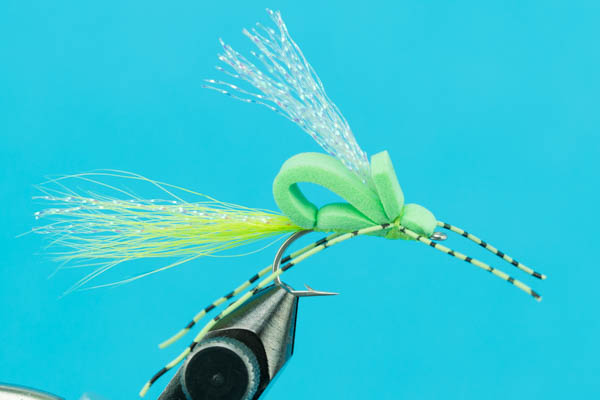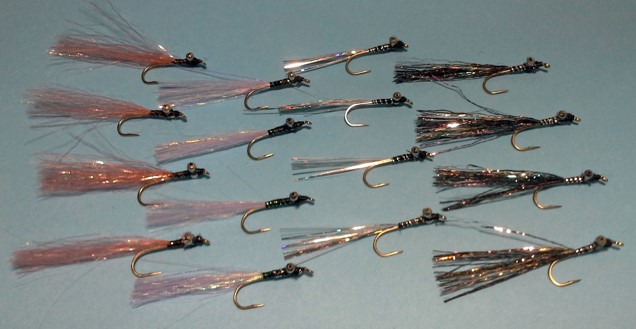A foam derivative of the Turck’s Tarantula, the Stealth Bomber is a foam diver/slider designed to duplicate the Tarantula’s diving motion and the resulting bubble trail made when the fly is stripped hard.
The rear tab of foam and the air space below it captures air, which bubbles on the dive. The turbulence it creates, along with the dynamics of the wing, cause the fly to wiggle side-to-side. And because it sits a little lower in the water than the traditional bass popper, the hook-up ratio is quite good.
Originally tied with black foam and only a basic tail, the fly resembled the B-2 Stealth bomber and its delta-wing. For black bass and big bream, I often tie some in bright color combinations and add flash wings and rubber legs. The “stealth” name hardly applies to its appearance, but its action can still be quite stealthy. With soft little strips it will wiggle and maybe “bloop” slightly. Strip with a just a little bit more vigour and it will dive and bubble, but still stay in the target zone (the strip here should be very quick, but very short). Give it a longer, harder strip and it will dive hard and create a major commotion.
Materials
- Hooks – Flopper (2x or 3x size 6 or 8),
scud 10 and bass 4 - Silver beads 7/64
- Lead free wire
- Rubber legs
- Ice dubbing
- Hare’s ear or similar dubbing
- Sparkle flash
- Soft fiber or EP type fibers

Tying Instructions

Step 1
Start your thread at the eye and wind back to a point forward of the bend.

Step 2
Tie in some soft fibre and Krystal Flash for a tail.

Step 3
Lay the foam body on top of the hook. Position it so the base of the triangle is behind the eye of the hook. Tie in the strip where the tail was tied in.

Step 4
Dub body under the foam to the ¾ quarter mark.

Step 5
Advance the thread back to a point behind the hook eye, wrap the chenille forward and tie off.

Step 6
Tie in the foam making a body segment.

Step 7
Tie down the foam body behind the hook eye at the base of the triangle. Make several tight wraps.
At this point I put a drop of super glue on both wraps at the front and back of the fly where the foam was tied in. Make sure the glue soaks into the wraps all around the body. You can use a tooth pick to pull some glue down onto the sides from the top of the body then add another drop to the underside.

Step 8
Tie in some strands of sparkle flash on top of the fly.

Step 9
Your triangle is too long at this point. Using straight scissors with the front of the foam facing you make a straight cut across. I’m cutting off about 5/8”. Then cut the points of the triangle off.

Step 10
Fold the triangle back, move your thread back and tie the foam down forming a head. Make several tight wraps. Add some more super glue to the thread all around the head and underneath including the wraps near the eye of the hook. Let the glue dry for a minute or two.

Step 11
Cut a piece of rubber long enough for two legs. Fold the rubber over the thread and wind them securely to the body on the back side of the fly. Do the same procedure on the side of the fly near you. Whip finish then add some more super glue to the wraps being careful not to get too much on the legs themselves making them stiffer. You can use several legs on each side, use fine rubber for more action or use medium round rubber and only four legs like I did here.

Step 12
After the glue dries you may add bars to the legs with a permanent marker. I use a Sharpie with a chisel point applicator.
I lay the legs of the finished fly on a piece of paper, apply the chisel to the leg then roll it back and forth in equal spaced points. This applies a band all around the rubber leg. Kent has a method of doing this by twisting the leg while in the vice, holding the marker on the leg then releasing the leg and the ink is applied as the leg un-twists. I didn’t watch him close enough at Troutfest and missed something. That does not work for me. There you have it, the finished Stealth Bomber.





